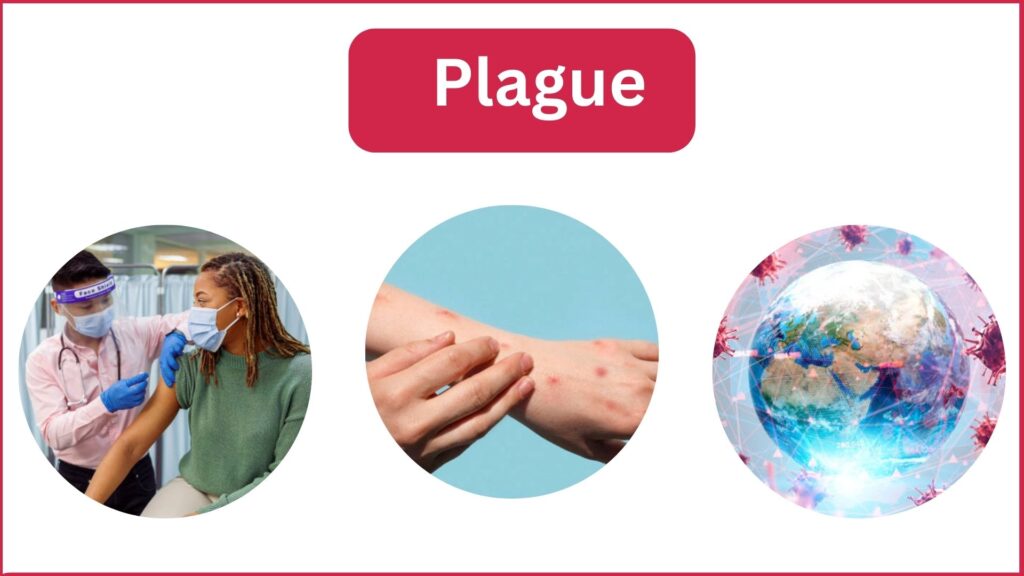Plague : Definition, plague doctor & prevention
Plague
We have described in article :
Definition of Plague
Classification of Plague
Transmission of Plague
Black death
Prevention and control of Plague epidemic

Definition of plague, wild plague, domestic plague :
Define Plague : Plague is an infectious disease of animals (Zoonosis), particularly wild and domestic rodents which is transmitted to man through the bite of infected ectoparasite, the rat flea. Domestic pets may carry plague infected rodent fleas into houses.
Define Wild plague : It may be defined as existing in nature independently of human population and their activities.
Define Domestic plague : Plague that is intimately associated with the man and rodents living with man and has a definite potential for producing epidemics.
Classification of plague :
1) Human plague :
- Bubonic plague : The common type, occurs primarily in the groin clinically characterized by fever prostration and painful enlargement of lymph nodes. It cannot spread from man to man.
- Pneumonic plague : it generally follows as a complication of bubonic-septicaemic plague. It spread from man to man by droplet infection.
- Septicaemic plague : Primary cases are rare Bubonic plague may develop into septicaemic plague.
2) Rodent plague :
- Wild plague.
- Domestic plague.
Mode of transmission of plague :
- Vector transmission : It is transmitted to man mainly by the bite of infected rat flea.
- Mechanical transmission : It may take place during the act of feeding by rat flea if the bacilli are present on the mouth part of the flea.
- Droplet infection : Pneumonic plague is spread directly from person to person by droplet infection.
Measures for the prevention of transmission of plague:
- Control of cases :
- Early diagnosis
- Notification
- Isolation
- Treatment
- Disinfection
2. Control of fleas.
3. Control of rodents.
4. Vaccination
5. Chemoprophylaxis.
6. Surveillance.
7. Health education.
Black death :
Black death : The 2nd pandemic originated in central Asia in fourteen century mostly involved European countries. One fourth population of Europe is estimated to have died and in some parts mortality was 70% of population It was named BLACK DEATH due to its great severity.
Plague has caused 3 world pandemics :
- 1st pandemic : The justinian plague, 6th century
- 2nd pandemic : The Black Death, 14″ century
- 3rd pandemic : Started in China in 1980 and reached the rest of the world the early years of the 20 century, it reached Honkong in 1894, where Yersin and Kitasato described the causative bacillus.
Prevention and control of plague epidemic :
- Control of rat population.
- Control of rat fleas : by insecticide spraying during outbreaks; it should be given priority rodent control.
- Vaccination : Immunization with plague vaccine is a valuable measure for the prevention of plague. Vaccination is done by plague vaccine in two doses of 0.5 and 1.0 ml at an interval of 1 week and it is given subcutaneously. Boosters are also necessary. Immunity lasts for 6 months Vaccine is given to all healthy persons in an affected area, to persons at high risk and to all travelers to hyper endemic areas.
- Chemoprophylaxis with tetracycline or sulfonamide for those exposed to the risk of infection.
- Control of human cases :
- Early diagnosis.
- Notification to local authorities as well as to WHO.
- Isolation of cases (strict isolation needed for pneumonic plague cases).
- Disinfection of soiled articles.
- Quarantine contacts with pneumonic plague should be placed under surveillance for 7 days.
- Health education during outbreak people should be made aware about the mode of spread of the disease.
- Treatment : Treatment is urgent and should be instituted if the diagnosis is suspected on clinical or epidemiological grounds. Streptomycin is given i.m or i. v every 6 or 12 hours, at daily dose of 30 mg/kg for 10 days or tetracycline, 10 mg/kg every 6 hours orally or intravenously for 10 days Intravenous fluids, pressor drugs, oxygen and incubation and mechanical ventilation are used as required.
International measures against plague :
- Telegraphic notification within 24 hours by governments to WHO.
- Measures applicable to ships aircafts and land transport arriving from plague affected areas are specified in International Health Regulation.
- Vaccination against plague cannot be required as a condition of admission to a territory.
- On arrival of an infested or suspected ship or an infested aircraft, travelers may be kept under surveillance for a period of not more than 6 days from the date of arrival.
- Plague is one of the quarantinable diseases, and as much special measures are taken at the ports in accordance with International Health Regulation.
Control of rat fleas :
The most effective method to break the chain of transmission (rodent-flea-man) is the destruction of rat fleas by the proper application of an effective insecticide. Flea control must precede or coincide anti-rodent measures.
In general DDT and BHC should be used as dust containing 10% and 3% of the active ingredient respectively. About 2-3 gm of insecticide formulation will be needed for each sq meter of surface requiring treatment.
Spraying is done inside the house covering the entire floor area, bottoms of all walls up to 3 feet above floor level back of the doors, roofing of thatched house crevices of walls, rat runs, clothing, bedding, cats, dogs and other pets.

Real wonderful information can be found on web site.